towing BMW ACTIVE HYBRID 5 2014 F10H Owner's Manual
[x] Cancel search | Manufacturer: BMW, Model Year: 2014, Model line: ACTIVE HYBRID 5, Model: BMW ACTIVE HYBRID 5 2014 F10HPages: 251, PDF Size: 5.36 MB
Page 53 of 251

The vehicle locks automatically after
you drive off.
Headlamp courtesy delay feature/ standing climate control
The settings are saved in the active profile, reāfer to page 37.
1."Settings"2."Doors/key"3. Select the symbol.4.Select the desired function:ā·"Pathway lighting"
Headlight courtesy delay featureā·"Comfort cooling"
Stationary climate control
Retrieving the seat, mirror, and
steering wheel settings
The driver's seat, exterior mirror, and steering
wheel position adjusted last will be stored for
the active profile.
When the vehicle is unlocked, these positions
are automatically retrieved if this function was
activated.
Pinch hazard when moving back the seat
If this function is used, first make sure
that the footwell behind the driver's seat is
empty. Otherwise, people might get injured or
objects damaged when the seat is moved
back.ā
The adjustment procedure is interrupted:
ā·When a seat position reel is pressed.ā·When a button of the seat, mirror, and
steering wheel memory is pressed briefly.
Activating the setting
1."Settings"2."Doors/key"3."Last seat position autom."Alarm system
The conceptWhen the vehicle is locked, the vehicle alarm
system responds to:ā·Opening a door, the hood or the trunk lid.ā·Movements in the interior.ā·Changes in the vehicle tilt, e. g., during atā
tempts at stealing a wheel or when towing
the car.ā·Disconnected battery voltage.
The alarm system briefly signals tampering:
ā·By sounding an acoustic alarm.ā·By switching on the hazard warning sysā
tem.ā·By flashing the daytime running lights.
Arming and disarming the alarm
system
When you unlock or lock the vehicle, either
with the remote control, Comfort Access or at
the door lock the alarm system is disarmed or
armed at the same time.
Door lock and armed alarm systemUnlocking via the door lock will trigger the
alarm on some country-specific versions.
Trunk lid and armed alarm system The trunk lid can be opened even when the
alarm system is armed.
After the trunk lid is closed, it is locked and
monitored again when the doors are locked.
The hazard warning system flashes once.
Panic mode
You can trigger the alarm system if you find
yourself in a dangerous situation.
Press button on the remote control for
at least 3 seconds.
To reel off the alarm: press any button.
Seite 49Opening and closingControls49
Online Edition for Part no. 01 40 2 956 272 - X/14
Page 122 of 251
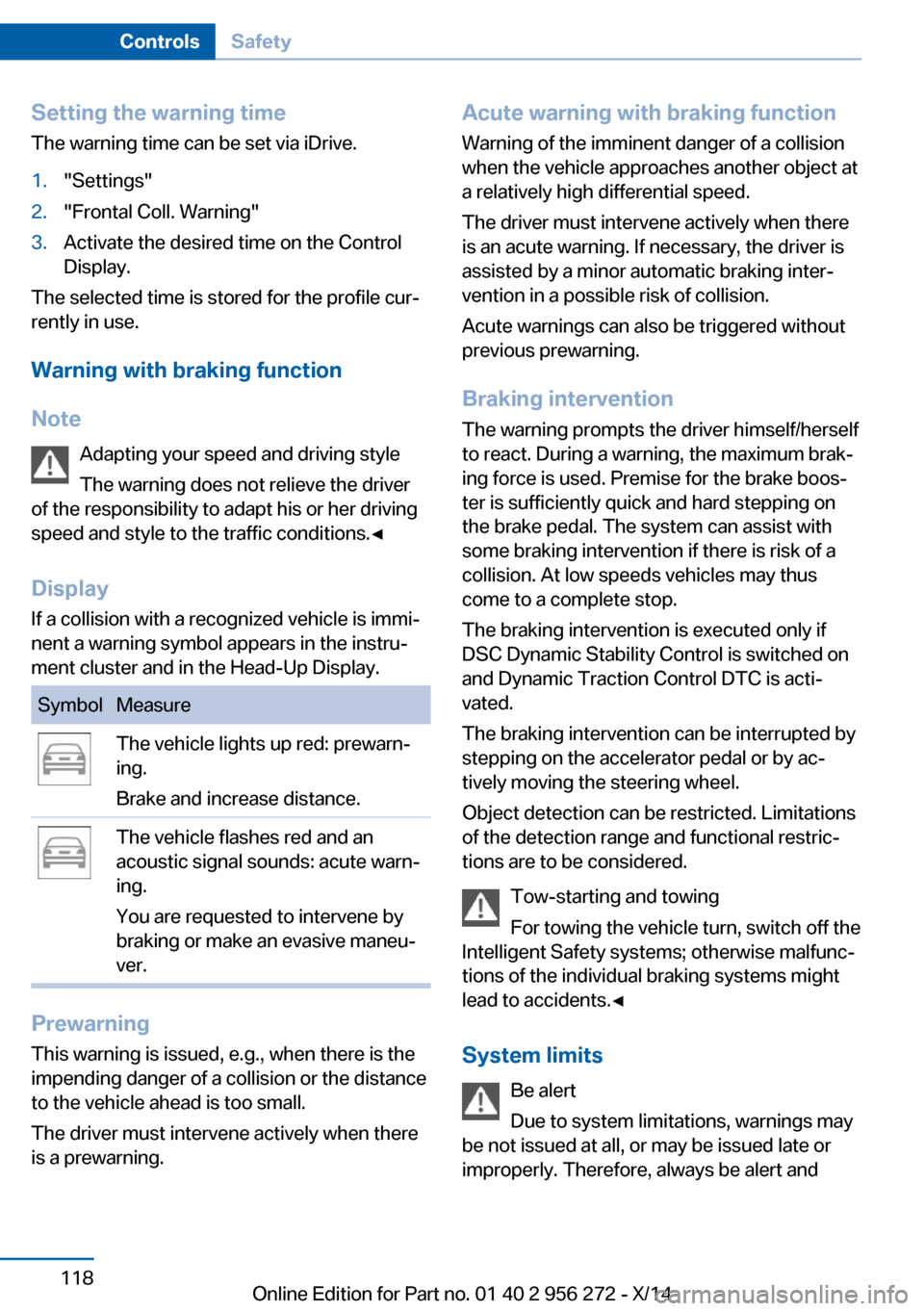
Setting the warning timeThe warning time can be set via iDrive.1."Settings"2."Frontal Coll. Warning"3.Activate the desired time on the Control
Display.
The selected time is stored for the profile curā
rently in use.
Warning with braking function
Note Adapting your speed and driving style
The warning does not relieve the driver
of the responsibility to adapt his or her driving
speed and style to the traffic conditions.ā
Display
If a collision with a recognized vehicle is immiā
nent a warning symbol appears in the instruā
ment cluster and in the Head-Up Display.
SymbolMeasureThe vehicle lights up red: prewarnā
ing.
Brake and increase distance.The vehicle flashes red and an
acoustic signal sounds: acute warnā
ing.
You are requested to intervene by
braking or make an evasive maneuā
ver.
Prewarning
This warning is issued, e.g., when there is the
impending danger of a collision or the distance
to the vehicle ahead is too small.
The driver must intervene actively when there
is a prewarning.
Acute warning with braking function
Warning of the imminent danger of a collision
when the vehicle approaches another object at
a relatively high differential speed.
The driver must intervene actively when there
is an acute warning. If necessary, the driver is
assisted by a minor automatic braking interā
vention in a possible risk of collision.
Acute warnings can also be triggered without
previous prewarning.
Braking intervention
The warning prompts the driver himself/herself
to react. During a warning, the maximum brakā
ing force is used. Premise for the brake boosā
ter is sufficiently quick and hard stepping on
the brake pedal. The system can assist with
some braking intervention if there is risk of a
collision. At low speeds vehicles may thus
come to a complete stop.
The braking intervention is executed only if
DSC Dynamic Stability Control is switched on
and Dynamic Traction Control DTC is actiā
vated.
The braking intervention can be interrupted by
stepping on the accelerator pedal or by acā
tively moving the steering wheel.
Object detection can be restricted. Limitations
of the detection range and functional restricā
tions are to be considered.
Tow-starting and towing
For towing the vehicle turn, switch off the
Intelligent Safety systems; otherwise malfuncā
tions of the individual braking systems might
lead to accidents.ā
System limits Be alert
Due to system limitations, warnings may
be not issued at all, or may be issued late or
improperly. Therefore, always be alert andSeite 118ControlsSafety118
Online Edition for Part no. 01 40 2 956 272 - X/14
Page 125 of 251

Warning with braking function
Note Adapting your speed and driving styleThe warning does not relieve the driver
of the responsibility to adapt his or her driving
speed and style to the traffic conditions.ā
Display If a collision with a recognized vehicle is immiā
nent a warning symbol appears in the instruā
ment cluster and in the Head-Up Display.SymbolMeasureThe vehicle lights up red: prewarnā
ing.
Brake and increase distance.The vehicle flashes red and an
acoustic signal sounds: acute warnā
ing.
You are requested to intervene by
braking or make an evasive maneuā
ver.
Prewarning
This warning is issued, e.g., when there is the
impending danger of a collision or the distance
to the vehicle ahead is too small.
The driver must intervene actively when there
is a prewarning.
Acute warning with braking function
Warning of the imminent danger of a collision
when the vehicle approaches another object at
a relatively high differential speed.
The driver must intervene actively when there
is an acute warning. If necessary, the driver is
assisted by an automatic braking intervention
in a possible risk of collision.
Acute warnings can also be triggered without
previous prewarning.
Braking intervention
The warning prompts the driver himself/herself
to react. During a warning, the maximum brakā
ing force is used. Premise for the brake boosā
ter is sufficiently quick and hard stepping on
the brake pedal. The system can assist with
automatic braking intervention if there is risk of
a collision. The intervention can bring the vehiā
cle to a complete stop.
The braking intervention is executed only if
DSC Dynamic Stability Control is switched on
and Dynamic Traction Control DTC is actiā
vated.
Above approx. 130 mph/210 km/h the braking
intervention occurs as a brief braking pressure.
No automatic delay occurs.
The braking intervention can be interrupted by
stepping on the accelerator pedal or by acā
tively moving the steering wheel.
Object detection can be restricted. Limitations
of the detection range and functional restricā
tions are to be considered.
Tow-starting and towing
For towing the vehicle turn, switch off the
Intelligent Safety systems; otherwise malfuncā
tions of the individual braking systems might
lead to accidents.ā
System limits Be alert
Due to system limitations, warnings may
be not issued at all, or may be issued late or
improperly. Therefore, always be alert and ready to intervene; otherwise, there is the risk
of an accident.ā
Detection range
The system's detection potential is limited.
Thus a warning might not be issued or be isā
sued late.
E. g. the following situations may not be deā
tected:Seite 121SafetyControls121
Online Edition for Part no. 01 40 2 956 272 - X/14
Page 128 of 251
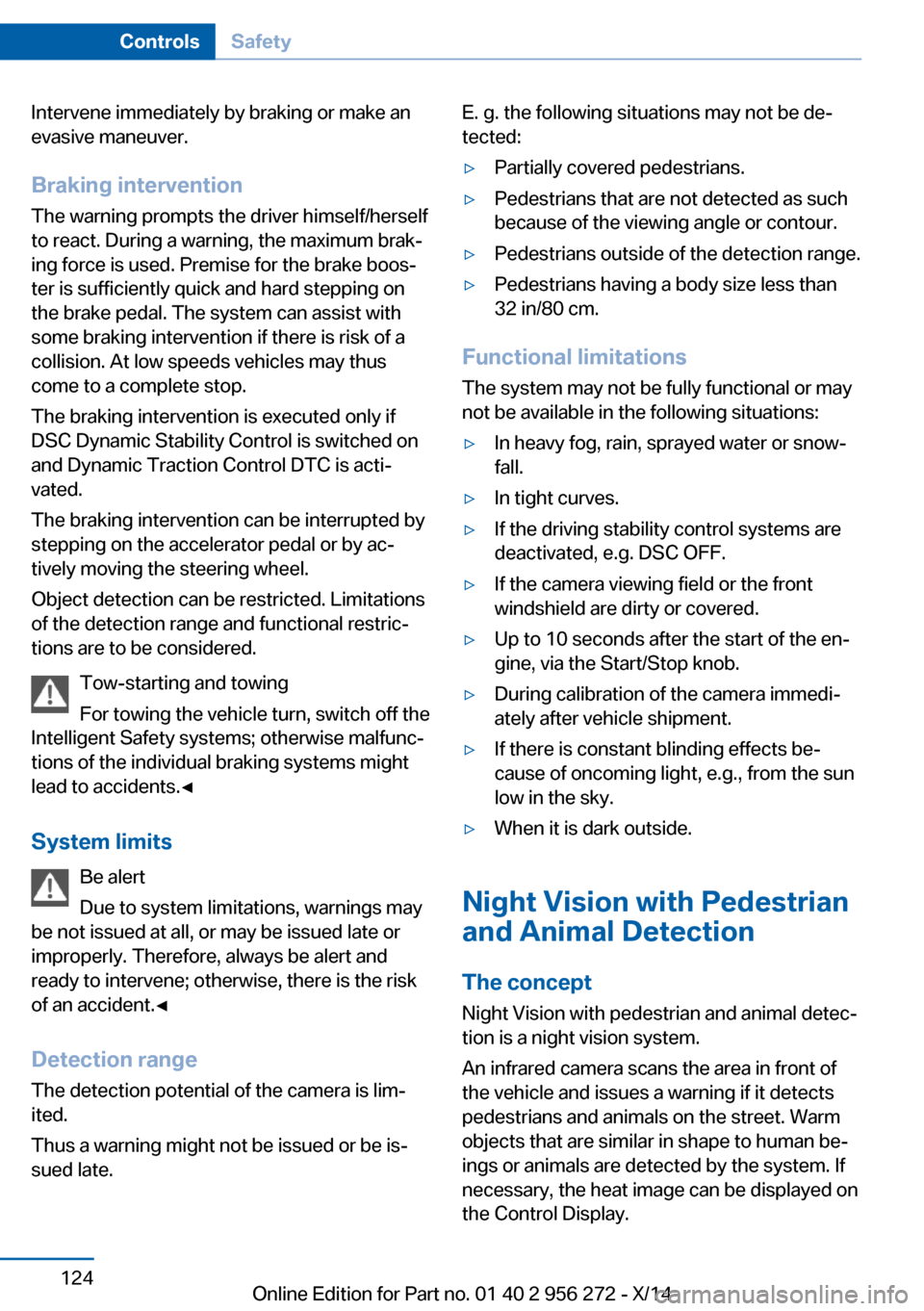
Intervene immediately by braking or make an
evasive maneuver.
Braking intervention The warning prompts the driver himself/herself
to react. During a warning, the maximum brakā
ing force is used. Premise for the brake boosā
ter is sufficiently quick and hard stepping on
the brake pedal. The system can assist with some braking intervention if there is risk of a
collision. At low speeds vehicles may thus
come to a complete stop.
The braking intervention is executed only if
DSC Dynamic Stability Control is switched on
and Dynamic Traction Control DTC is actiā
vated.
The braking intervention can be interrupted by
stepping on the accelerator pedal or by acā
tively moving the steering wheel.
Object detection can be restricted. Limitations
of the detection range and functional restricā
tions are to be considered.
Tow-starting and towing
For towing the vehicle turn, switch off the
Intelligent Safety systems; otherwise malfuncā
tions of the individual braking systems might
lead to accidents.ā
System limits Be alert
Due to system limitations, warnings may
be not issued at all, or may be issued late or
improperly. Therefore, always be alert and ready to intervene; otherwise, there is the risk
of an accident.ā
Detection range
The detection potential of the camera is limā
ited.
Thus a warning might not be issued or be isā
sued late.E. g. the following situations may not be deā
tected:ā·Partially covered pedestrians.ā·Pedestrians that are not detected as such
because of the viewing angle or contour.ā·Pedestrians outside of the detection range.ā·Pedestrians having a body size less than
32 in/80 cm.
Functional limitations
The system may not be fully functional or may
not be available in the following situations:
ā·In heavy fog, rain, sprayed water or snowā
fall.ā·In tight curves.ā·If the driving stability control systems are
deactivated, e.g. DSC OFF.ā·If the camera viewing field or the front
windshield are dirty or covered.ā·Up to 10 seconds after the start of the enā
gine, via the Start/Stop knob.ā·During calibration of the camera immediā
ately after vehicle shipment.ā·If there is constant blinding effects beā
cause of oncoming light, e.g., from the sun
low in the sky.ā·When it is dark outside.
Night Vision with Pedestrian
and Animal Detection
The concept Night Vision with pedestrian and animal detecā
tion is a night vision system.
An infrared camera scans the area in front of
the vehicle and issues a warning if it detects
pedestrians and animals on the street. Warm
objects that are similar in shape to human beā
ings or animals are detected by the system. If necessary, the heat image can be displayed on
the Control Display.
Seite 124ControlsSafety124
Online Edition for Part no. 01 40 2 956 272 - X/14
Page 190 of 251

Load
The maximum load is the sum of the weight of
the occupants and the cargo.
The greater the weight of the occupants, the
less cargo that can be transported.
Stowing cargo
ā·The cover of the high-voltage battery is loā
cated in the cargo area. Do not remove the
cover to stow luggage.ā·Cover sharp edges and corners on the
cargo.ā·Heavy cargo: stow as far forward as possiā
ble, directly behind and at the bottom of
the rear passenger seat backrests.ā·Very heavy cargo: when the rear seat is not
occupied, secure each of the outer safety
belts in the opposite buckle.Securing cargo
Lashing eyes in the cargo area
To secure the cargo there are two lashing eyes
underneath the loading lip in the cargo area.
Securing cargo
ā·Smaller and lighter items: secure with reā
taining straps or with a cargo net or draw
straps.ā·Larger and heavy objects: secure with
cargo straps.
Cargo straps, cargo netting, retaining straps or
draw straps on the lashing eyes in the cargo
area.
Securing cargo
Stow and secure the cargo as described
above; otherwise it may present a danger to
the occupants, e.g., during braking and evasive
maneuvers.ā
Roof-mounted luggage rack Note
Roof racks are available as special accessories.
Securing
Follow the installation instructions of the roof
rack.
Seite 186Driving tipsLoading186
Online Edition for Part no. 01 40 2 956 272 - X/14
Page 229 of 251
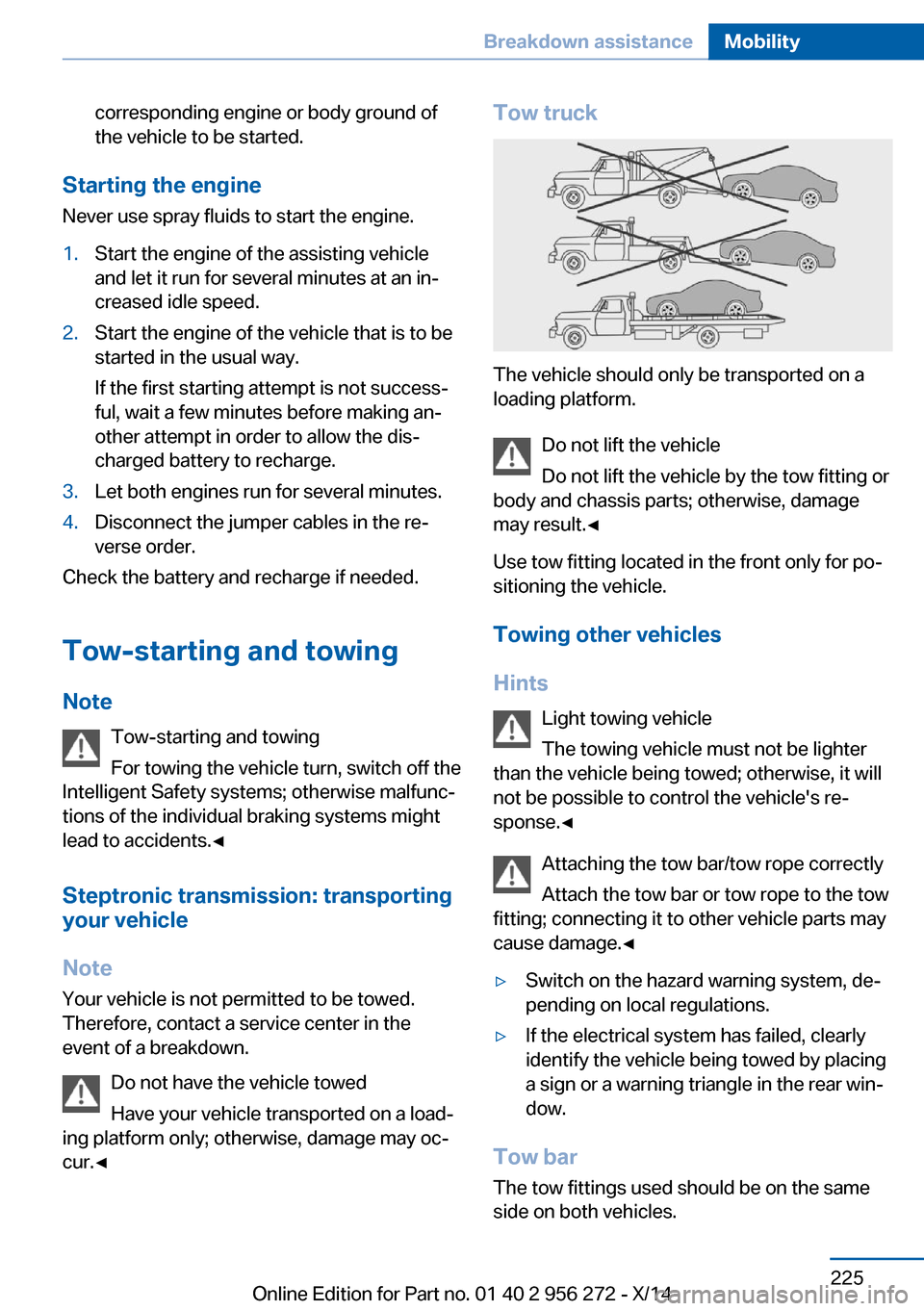
corresponding engine or body ground of
the vehicle to be started.
Starting the engine
Never use spray fluids to start the engine.
1.Start the engine of the assisting vehicle
and let it run for several minutes at an inā
creased idle speed.2.Start the engine of the vehicle that is to be
started in the usual way.
If the first starting attempt is not successā
ful, wait a few minutes before making anā
other attempt in order to allow the disā
charged battery to recharge.3.Let both engines run for several minutes.4.Disconnect the jumper cables in the reā
verse order.
Check the battery and recharge if needed.
Tow-starting and towing Note Tow-starting and towing
For towing the vehicle turn, switch off the
Intelligent Safety systems; otherwise malfuncā
tions of the individual braking systems might
lead to accidents.ā
Steptronic transmission: transporting
your vehicle
Note Your vehicle is not permitted to be towed.
Therefore, contact a service center in the
event of a breakdown.
Do not have the vehicle towedHave your vehicle transported on a loadā
ing platform only; otherwise, damage may ocā
cur.ā
Tow truck
The vehicle should only be transported on a
loading platform.
Do not lift the vehicle
Do not lift the vehicle by the tow fitting or
body and chassis parts; otherwise, damage
may result.ā
Use tow fitting located in the front only for poā
sitioning the vehicle.
Towing other vehicles
Hints Light towing vehicle
The towing vehicle must not be lighter
than the vehicle being towed; otherwise, it will
not be possible to control the vehicle's reā
sponse.ā
Attaching the tow bar/tow rope correctly
Attach the tow bar or tow rope to the tow
fitting; connecting it to other vehicle parts may
cause damage.ā
ā·Switch on the hazard warning system, deā
pending on local regulations.ā·If the electrical system has failed, clearly
identify the vehicle being towed by placing
a sign or a warning triangle in the rear winā
dow.
Tow bar
The tow fittings used should be on the same
side on both vehicles.
Seite 225Breakdown assistanceMobility225
Online Edition for Part no. 01 40 2 956 272 - X/14
Page 230 of 251
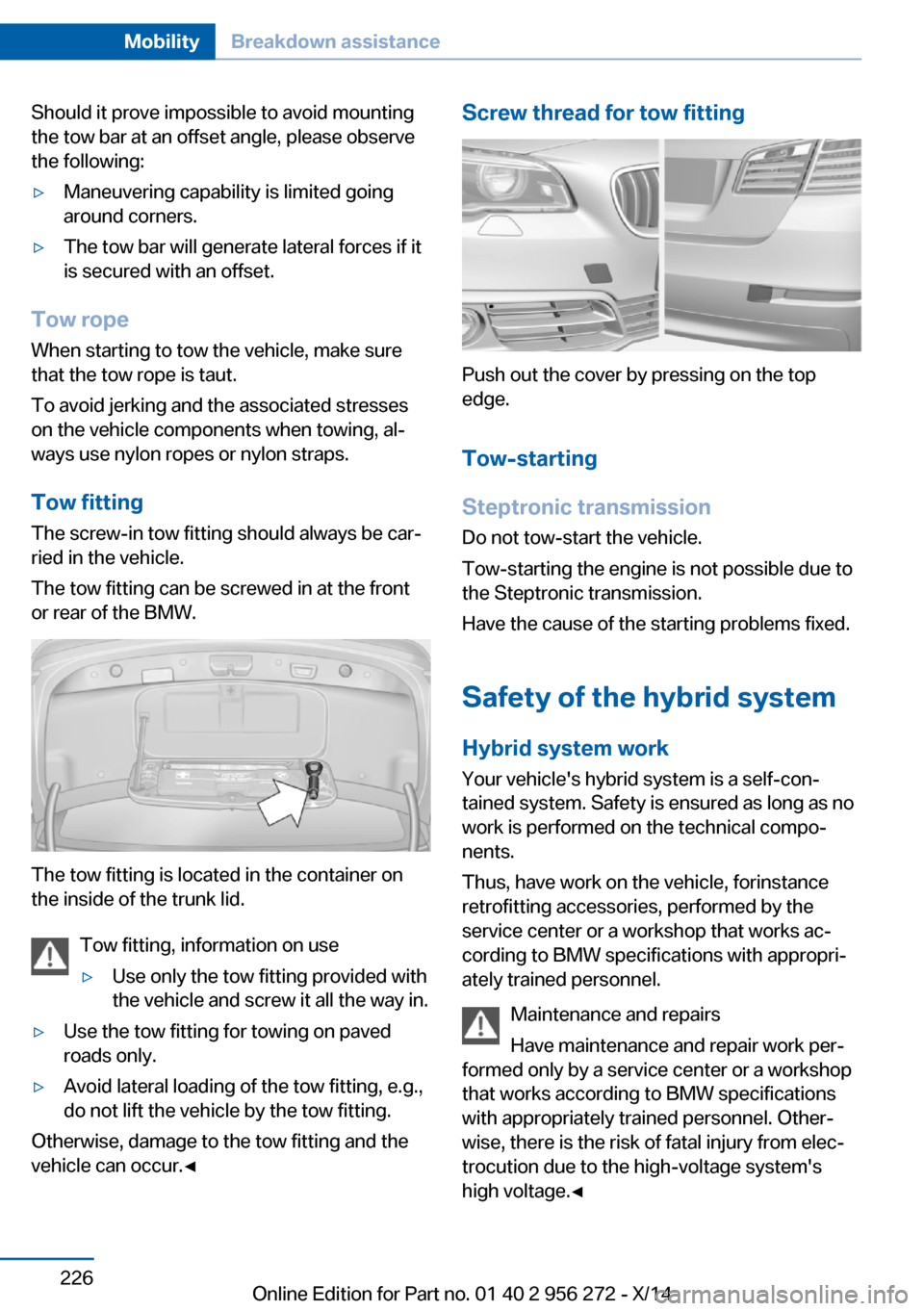
Should it prove impossible to avoid mounting
the tow bar at an offset angle, please observe
the following:ā·Maneuvering capability is limited going
around corners.ā·The tow bar will generate lateral forces if it
is secured with an offset.
Tow rope
When starting to tow the vehicle, make sure
that the tow rope is taut.
To avoid jerking and the associated stresses
on the vehicle components when towing, alā
ways use nylon ropes or nylon straps.
Tow fitting
The screw-in tow fitting should always be carā
ried in the vehicle.
The tow fitting can be screwed in at the front
or rear of the BMW.
The tow fitting is located in the container on
the inside of the trunk lid.
Tow fitting, information on use
ā·Use only the tow fitting provided with
the vehicle and screw it all the way in.ā·Use the tow fitting for towing on paved
roads only.ā·Avoid lateral loading of the tow fitting, e.g.,
do not lift the vehicle by the tow fitting.
Otherwise, damage to the tow fitting and the
vehicle can occur.ā
Screw thread for tow fitting
Push out the cover by pressing on the top
edge.
Tow-starting
Steptronic transmission Do not tow-start the vehicle.
Tow-starting the engine is not possible due to
the Steptronic transmission.
Have the cause of the starting problems fixed.
Safety of the hybrid system Hybrid system workYour vehicle's hybrid system is a self-conā
tained system. Safety is ensured as long as no
work is performed on the technical compoā
nents.
Thus, have work on the vehicle, forāinstance
retrofitting accessories, performed by the
service center or a workshop that works acā
cording to BMW specifications with appropriā
ately trained personnel.
Maintenance and repairs
Have maintenance and repair work perā
formed only by a service center or a workshop
that works according to BMW specifications
with appropriately trained personnel. Otherā
wise, there is the risk of fatal injury from elecā
trocution due to the high-voltage system's
high voltage.ā
Seite 226MobilityBreakdown assistance226
Online Edition for Part no. 01 40 2 956 272 - X/14
Page 240 of 251

Everything from A to Z
IndexA ABS, Antilock Brake Sysā tem 134
ACC, Active Cruise Control with Stop & Go 139
Activated-charcoal filter 163
Activate drive readiness 72
Active Blind Spot Detecā tion 129
Active Cruise Control with Stop & Go, ACC 139
ActiveHybrid, system 31
Active Protection 131
Active seat, front 58
Active seat ventilation, front 59
Adapting to the course of the road, hybrid system 88
Adaptive brake assistant 134
Adaptive brake lights, refer to Brake force display 131
Adaptive Light Control 103
Additives, oil 209
Adjustments, seats/head reā straints 55
After washing vehicle 229
Airbags 107
Airbags, indicator/warning light 108
Air circulation, refer to Recirā culated-air mode 162
Air, dehumidifying, refer to Cooling function 162
Air distribution, manual 161
Air flow, automatic climate control 161
Air outlets, see ventilaā tion 163
Air pressure, tires 198
Alarm system 49 Alarm, unintentional 50
All around the center conā sole 16
All around the roofliner 17
All around the steering wheel 14
All-season tires, refer to Winā ter tires 204
Alternating-code hand-held transmitter 169
Alternative oil types 210
Ambient light 105
Animal detection, see Night Vision 124
Antifreeze, washer fluid 81
Antilock Brake System, ABS 134
Anti-slip control, refer to DSC 134
Approved axle load 235
Approved engine oils 210
Armrest, refer to Center armā rest 175
Arrival time 97
Ashtray 170
Ashtray, front 170
Ashtray, rear 171
Assistance for the combusā tion engine, ASSIST 75
Assistance for the combusā tion engine, eBOOST 75
Assistance, Roadside Assisā tance 223
Assistance when driving off 134
ASSIST, assistance for the combustion engine 75
Attentiveness assistant 131
AUTO H button 76
AUTO H button, refer to Auā tomatic Hold 76 AUTO intensity 161
Automatic car wash 228
Automatic climate conā trol 160
Automatic Cruise Control with Stop & Go 139
Automatic Curb Monitor 64
Automatic deactivation, front- seat passenger airbags 109
Automatic deactivation of the hybrid system 227
Automatic engine start-stop function 73
Automatic headlight conā trol 103
Automatic Hold 76
Automatic locking 48
Automatic recirculated-air control 162
Automatic Soft Closing, doors 42
Automatic transmission, see Steptronic transmission 81
Automatic trunk lid 43
AUTO program, automatic cliā mate control 161
AUTO program, intensity 161
Auxiliary air conditioning 167
Average fuel consumption 97
Average speed 97
Axle loads, weights 235
B Backrest curvature, refer to Lumbar support 57
Backrest, width 57
Band-aids, refer to First aid kit 223
Bar for tow-starting/ towing 225 Seite 236ReferenceEverything from A to Z236
Online Edition for Part no. 01 40 2 956 272 - X/14
Page 243 of 251
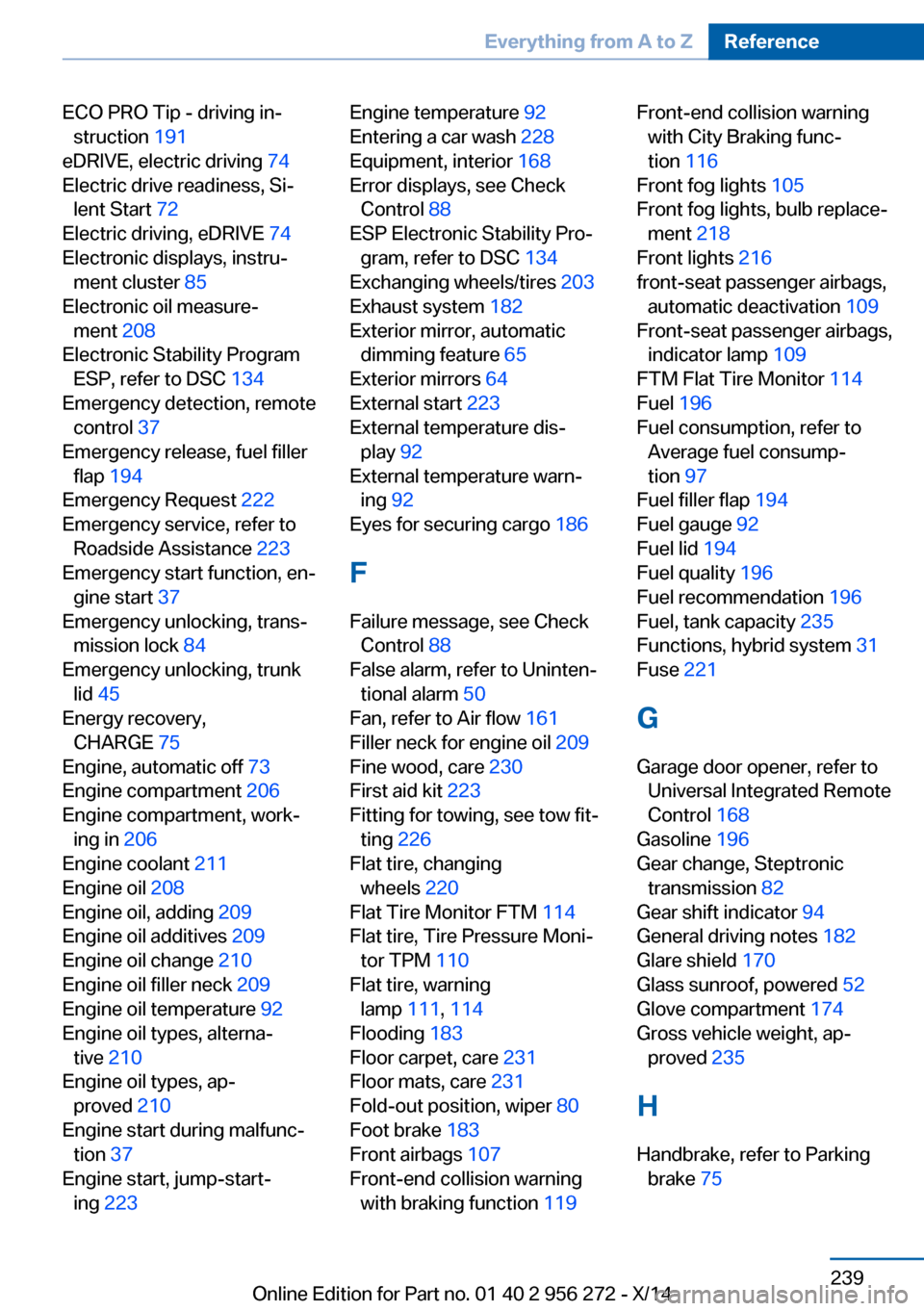
ECO PRO Tip - driving ināstruction 191
eDRIVE, electric driving 74
Electric drive readiness, Siā lent Start 72
Electric driving, eDRIVE 74
Electronic displays, instruā ment cluster 85
Electronic oil measureā ment 208
Electronic Stability Program ESP, refer to DSC 134
Emergency detection, remote control 37
Emergency release, fuel filler flap 194
Emergency Request 222
Emergency service, refer to Roadside Assistance 223
Emergency start function, enā gine start 37
Emergency unlocking, transā mission lock 84
Emergency unlocking, trunk lid 45
Energy recovery, CHARGE 75
Engine, automatic off 73
Engine compartment 206
Engine compartment, workā ing in 206
Engine coolant 211
Engine oil 208
Engine oil, adding 209
Engine oil additives 209
Engine oil change 210
Engine oil filler neck 209
Engine oil temperature 92
Engine oil types, alternaā tive 210
Engine oil types, apā proved 210
Engine start during malfuncā tion 37
Engine start, jump-startā ing 223 Engine temperature 92
Entering a car wash 228
Equipment, interior 168
Error displays, see Check Control 88
ESP Electronic Stability Proā gram, refer to DSC 134
Exchanging wheels/tires 203
Exhaust system 182
Exterior mirror, automatic dimming feature 65
Exterior mirrors 64
External start 223
External temperature disā play 92
External temperature warnā ing 92
Eyes for securing cargo 186
F
Failure message, see Check Control 88
False alarm, refer to Unintenā tional alarm 50
Fan, refer to Air flow 161
Filler neck for engine oil 209
Fine wood, care 230
First aid kit 223
Fitting for towing, see tow fitā ting 226
Flat tire, changing wheels 220
Flat Tire Monitor FTM 114
Flat tire, Tire Pressure Moniā tor TPM 110
Flat tire, warning lamp 111, 114
Flooding 183
Floor carpet, care 231
Floor mats, care 231
Fold-out position, wiper 80
Foot brake 183
Front airbags 107
Front-end collision warning with braking function 119 Front-end collision warning
with City Braking funcā
tion 116
Front fog lights 105
Front fog lights, bulb replaceā ment 218
Front lights 216
front-seat passenger airbags, automatic deactivation 109
Front-seat passenger airbags, indicator lamp 109
FTM Flat Tire Monitor 114
Fuel 196
Fuel consumption, refer to Average fuel consumpā
tion 97
Fuel filler flap 194
Fuel gauge 92
Fuel lid 194
Fuel quality 196
Fuel recommendation 196
Fuel, tank capacity 235
Functions, hybrid system 31
Fuse 221
G
Garage door opener, refer to Universal Integrated Remote
Control 168
Gasoline 196
Gear change, Steptronic transmission 82
Gear shift indicator 94
General driving notes 182
Glare shield 170
Glass sunroof, powered 52
Glove compartment 174
Gross vehicle weight, apā proved 235
H
Handbrake, refer to Parking brake 75 Seite 239Everything from A to ZReference239
Online Edition for Part no. 01 40 2 956 272 - X/14
Page 244 of 251
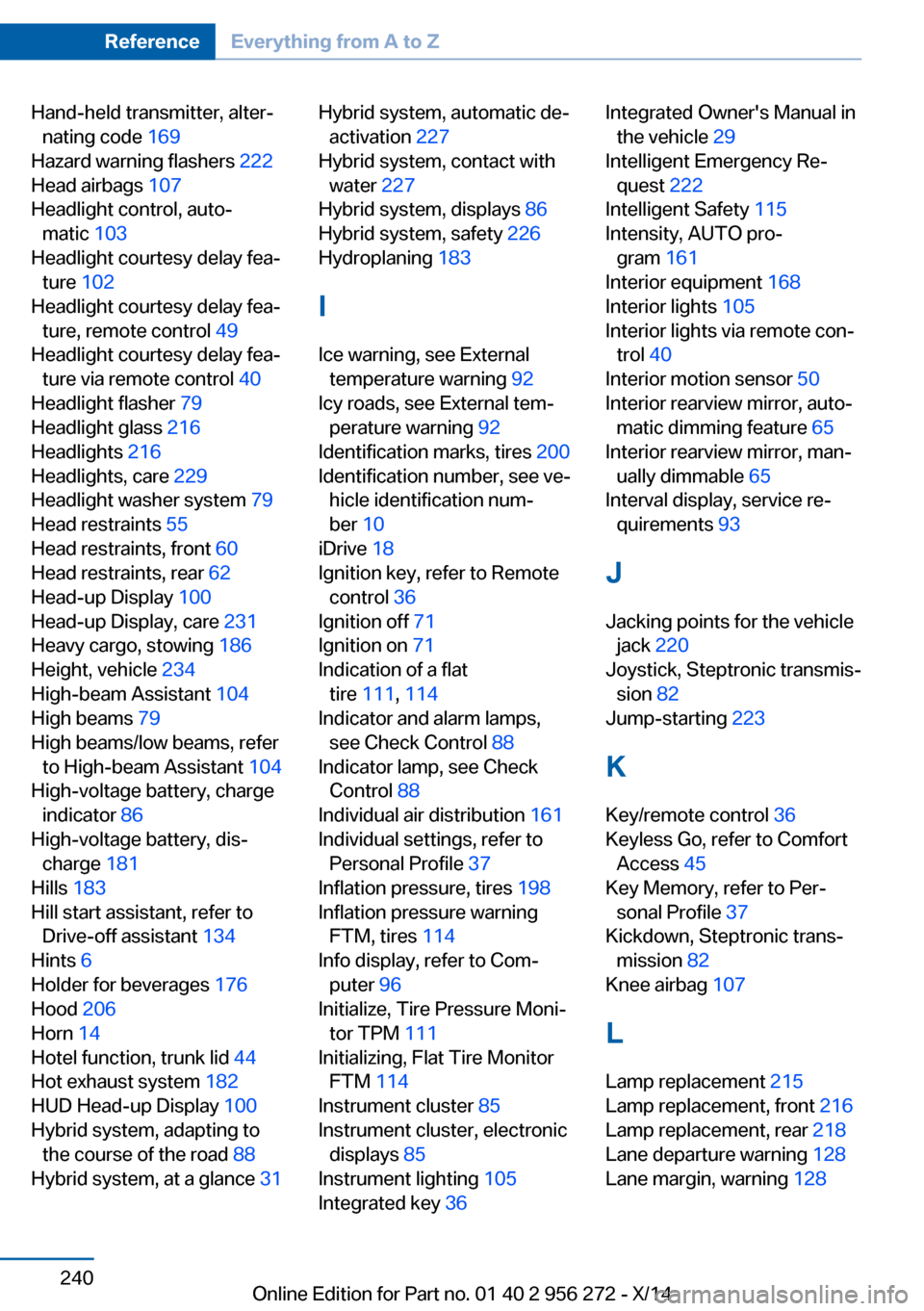
Hand-held transmitter, alterānating code 169
Hazard warning flashers 222
Head airbags 107
Headlight control, autoā matic 103
Headlight courtesy delay feaā ture 102
Headlight courtesy delay feaā ture, remote control 49
Headlight courtesy delay feaā ture via remote control 40
Headlight flasher 79
Headlight glass 216
Headlights 216
Headlights, care 229
Headlight washer system 79
Head restraints 55
Head restraints, front 60
Head restraints, rear 62
Head-up Display 100
Head-up Display, care 231
Heavy cargo, stowing 186
Height, vehicle 234
High-beam Assistant 104
High beams 79
High beams/low beams, refer to High-beam Assistant 104
High-voltage battery, charge indicator 86
High-voltage battery, disā charge 181
Hills 183
Hill start assistant, refer to Drive-off assistant 134
Hints 6
Holder for beverages 176
Hood 206
Horn 14
Hotel function, trunk lid 44
Hot exhaust system 182
HUD Head-up Display 100
Hybrid system, adapting to the course of the road 88
Hybrid system, at a glance 31 Hybrid system, automatic deā
activation 227
Hybrid system, contact with water 227
Hybrid system, displays 86
Hybrid system, safety 226
Hydroplaning 183
I Ice warning, see External temperature warning 92
Icy roads, see External temā perature warning 92
Identification marks, tires 200
Identification number, see veā hicle identification numā
ber 10
iDrive 18
Ignition key, refer to Remote control 36
Ignition off 71
Ignition on 71
Indication of a flat tire 111 , 114
Indicator and alarm lamps, see Check Control 88
Indicator lamp, see Check Control 88
Individual air distribution 161
Individual settings, refer to Personal Profile 37
Inflation pressure, tires 198
Inflation pressure warning FTM, tires 114
Info display, refer to Comā puter 96
Initialize, Tire Pressure Moniā tor TPM 111
Initializing, Flat Tire Monitor FTM 114
Instrument cluster 85
Instrument cluster, electronic displays 85
Instrument lighting 105
Integrated key 36 Integrated Owner's Manual in
the vehicle 29
Intelligent Emergency Reā quest 222
Intelligent Safety 115
Intensity, AUTO proā gram 161
Interior equipment 168
Interior lights 105
Interior lights via remote conā trol 40
Interior motion sensor 50
Interior rearview mirror, autoā matic dimming feature 65
Interior rearview mirror, manā ually dimmable 65
Interval display, service reā quirements 93
J Jacking points for the vehicle jack 220
Joystick, Steptronic transmisā sion 82
Jump-starting 223
K
Key/remote control 36
Keyless Go, refer to Comfort Access 45
Key Memory, refer to Perā sonal Profile 37
Kickdown, Steptronic transā mission 82
Knee airbag 107
L Lamp replacement 215
Lamp replacement, front 216
Lamp replacement, rear 218
Lane departure warning 128
Lane margin, warning 128 Seite 240ReferenceEverything from A to Z240
Online Edition for Part no. 01 40 2 956 272 - X/14